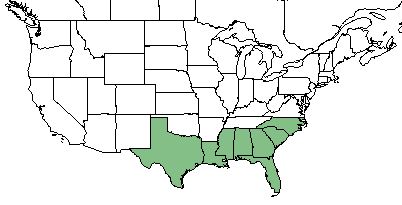Anthaenantia villosa
Common Names: Green Silkyscale
| Anthaenantia villosa | |
|---|---|
| Scientific classification | |
| Kingdom: | Plantae |
| Division: | Magnoliophyta - Flowering plants |
| Class: | Liliopsida - Monocots |
| Order: | Cyperales |
| Family: | Poaceae |
| Genus: | Anthaenantia |
| Species: | A. villosa |
| Binomial name | |
| Anthaenantia villosa (Michaux) P. Beauv. | |

| |
| Natural range of Anthaenantia villosa from USDA NRCS Plants Database. | |
Contents
Taxonomic Notes
Synonyms: Anthenantia villosa (Michx.) P. Beauv., orthographic variant[1]
Varieties: none.[1]
Description
A. villosa is a perennial graminoid in the Poaceae family native to the southeastern United States. [2] It is ascending (with a slight lean) in overall growth, and has short rhizomes.[3][4]
Distribution
A. villosa can be found in a number of southeastern states including Florida, Georgia, Alabama, South Carolina, North Carolina, Louisiana, Mississippi, and Texas. [2]
The Anthaenantia genera is endemic to the longleaf pine range from southeastern Virginia to central Florida and west to southeast Texas.[5]
Ecology
Habitat
A. villosa is found in longleaf pine regions. This grass excels in more exculsively longleaf pine regions during times of higher levels of needle fall from the canopy. [4][6] Mild competition is beneficial to viable seed production for A. villosa, making the species more likely to thrive in a variety of competitive environments. [3] Habitats that specimens of A. villosa have been recovered from include dry sandy edges of coastal flatwoods, sandy peat of flatwoods, turkey oak sand ridge, open live hammock, savanna, edge of longleaf pinelands, grassy roadside with pine overstory, and mixed woodland [7] It has become absent in response to agricultural practices in southwest Georgia. It has also shown resistance to regrowth in reestablished savanna communities that were disturbed by agricultural practices.[8] A. villosa does not respond to soil disturbance by clearcutting and chopping in North Florida flatwoods forests.[9]
Phenology
It has been observed flowering in September and November, and fruiting in September and October.[10][7]
Seed dispersal
This species is thought to be dispersed by gravity. [11]
Fire ecology
Populations of Anthaenantia villosa have been known to persist through repeated annual burns.[12]
Pollination
Anthaenantia villosa is wind-pollinated instead of reliant on insects or other animals for pollination. [6] A. villosa is a bunchgrass that is used by herbivorous animals, including cattle.[13][6] It is grazed primarily in the summer, and tends to increase under cattle grazing.[14]
Conservation, cultivation, and restoration
A. villosa should avoid soil disturbance by agricultural practices to conserve its presence in pine communities.[8]
Cultural use
Photo Gallery
References and notes
- ↑ 1.0 1.1 Weakley, A.S. 2020. Flora of the Southeastern United States. Edition of 20 October 2020. University of North Carolina at Chapel Hill, Chapel Hill, North Carolina.
- ↑ 2.0 2.1 USDA Plant Database
- ↑ 3.0 3.1 Dagley, C. M., et al. (2002). "Understory restoration in longleaf pine plantations: Overstory effects of competition and needlefall." Proceedings of the eleventh biennial southern silvicultural research conference.
- ↑ 4.0 4.1 Harrington, T., et al. (2003). "Above and Below ground Competition from Longleaf Pine Plantations Limits Performance of Reintroduced Herbaceous Species." Forest Science 49(5): 681-695.
- ↑ Sorrie, B. A. and A. S. Weakley 2001. Coastal Plain valcular plant endemics: Phytogeographic patterns. Castanea 66: 50-82.
- ↑ 6.0 6.1 6.2 [Brudvig, L. A., et al. (2015).
Herbivory and toxicology
"The influence of habitat fragmentation on multiple plant-animal interactions and plant reproduction." Ecology 96(10): 2669-2678] Cite error: Invalid
<ref>tag; name "Brudvig" defined multiple times with different content - ↑ 7.0 7.1 URL: http://herbarium.bio.fsu.edu. Last accessed: June 2018. Collectors: Loran C. Anderson, Gil Nelson, R.K. Godfrey, R. Kral, D. L. Martin, S. T. Cooper, Frank Tomkow, Richard D. Houk, J. B. Morrill, A. H. Curtiss, A. Gholson Jr., Angus Gholson, James D. Ray, Jr., O. Lakela, Gary R. Knight, Cecil R Slaughter, Helen Roth, M. Darst, L. Reed. States and counties: Florida (Wakulla, Okaloosa, Levy, Liberty, Madison, Marion, Pasco, Putnam, Santa Rosa, Calhoun, Duval, Franklin, Gadsden, Hernando, Hillsborough, Jackson, Jefferson, Leon) Georgia (Baker)
- ↑ 8.0 8.1 Kirkman, L.K., K.L. Coffey, R.J. Mitchell, and E.B. Moser. Ground Cover Recovery Patterns and Life-History Traits: Implications for Restoration Obstacles and Opportunities in a Species-Rich Savanna. (2004). Journal of Ecology 92(3):409-421.
- ↑ Moore, W.H., B.F. Swindel, and W.S. Terry. (1982). Vegetative Response to Clearcutting and Chopping in a North Florida Flatwoods Forest. Journal of Range Management 35(2):214-218.
- ↑ Nelson, G. PanFlora: Plant data for the eastern United States with emphasis on the Southeastern Coastal Plains, Florida, and the Florida Panhandle. www.gilnelson.com/PanFlora/ Accessed: 13 MAR 2019
- ↑ Kirkman, L. Katherine. Unpublished database of seed dispersal mode of plants found in Coastal Plain longleaf pine-grasslands of the Jones Ecological Research Center, Georgia.
- ↑ Robertson, K.M. Unpublished data collected from Pebble Hill Fire Plots, Pebble Hill Plantation, Thomasville, Georgia.
- ↑ Pearson, H. A., et al. (1982). Botanical composition and nutritive value of cattle diets on southern pine range. New Orleans, LA, USDA Forest Service, Research Paper SO-178.: 24.
- ↑ Byrd, Nathan A. (1980). "Forestland Grazing: A Guide For Service Foresters In The South." U.S. Department of Agriculture.